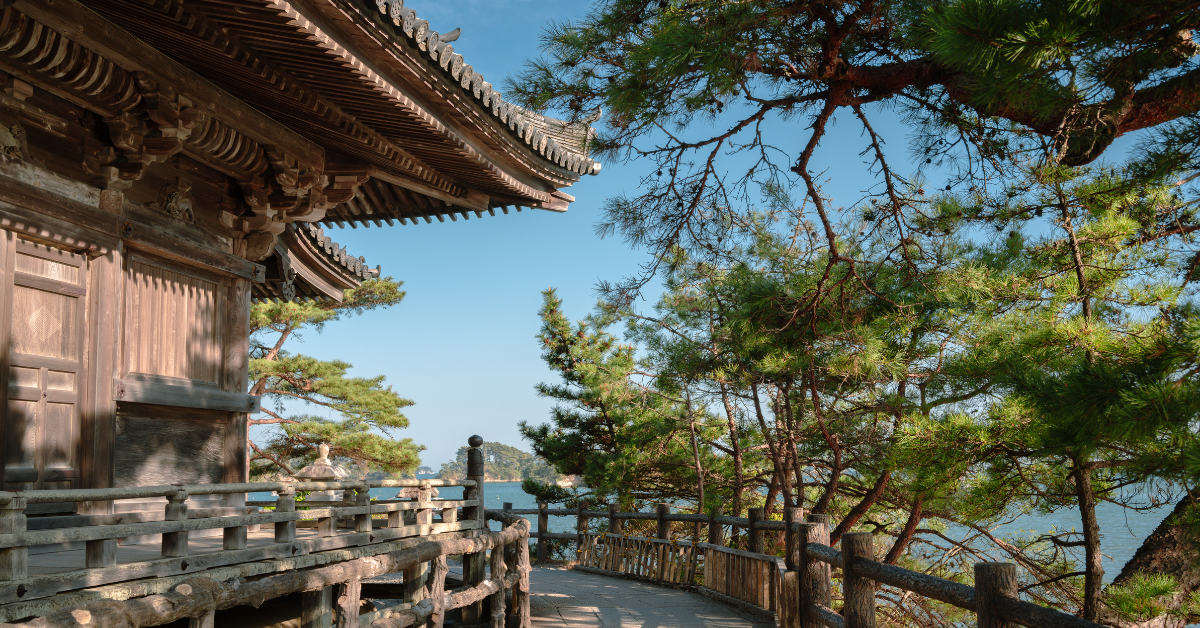Zuiganji Main Hall, located in Matsushima, is a National Treasure that preserves the brilliance of the Momoyama period. Visitors can experience both Japan’s history and spirituality through its architecture, fusuma paintings, and wooden carvings.
History of Zuiganji Main Hall
Zuiganji was founded in the Heian period, and later converted into a Zen temple during the Kamakura era. The current Main Hall was reconstructed by Date Masamune in 1609. After an age of wars, the temple became not only a spiritual center for the region but also a symbolic structure showing Masamune’s authority and refined aesthetic sense.
The reconstruction of the Main Hall was more than a religious act. It was a large-scale project to display the lord’s prestige to Japan and beyond. The finest craftsmen and artists of the time were gathered, resulting in a grand temple complex that today remains an invaluable cultural property representing the brilliance of Momoyama culture.
Architectural Style of Zuiganji Main Hall
Zuiganji Main Hall is characterized by the fusion of Zen style and Momoyama style. While the exterior is solemn and majestic, the interior is adorned with luxurious decorations. Fusuma (sliding doors) and wall paintings created by painters of the Kano school remain preserved, turning the entire building into a work of art.
The following table summarizes the main architectural features.
| Item | Description |
|---|---|
| Style | Fusion of Zen and Momoyama styles |
| Builder | Date Masamune |
| Designation | National Treasure |
| Decorations | Fusuma paintings by the Kano school, fine wood carvings |
| Period | Early Edo (around 1609) |
Artistic Value of Zuiganji Main Hall
The most striking feature of the Main Hall is its magnificent fusuma paintings. Seasonal flowers, birds, and landscapes are depicted, blending nature with a religious worldview. The pillars and beams are elaborately carved, making the building itself feel like a piece of art.
The artistic qualities can be organized as follows:
| Artistic Element | Feature |
|---|---|
| Fusuma paintings | Kano school paintings of flowers, birds, and scenery |
| Wood carvings | Detailed carvings decorating beams and pillars |
| Colors | Vivid pigments and gold leaf decorations |
| Spatial design | Harmony of solemnity and tranquility |
Cultural Value of Zuiganji Main Hall
Zuiganji Main Hall is more than a religious structure. It is a cultural symbol. While it preserves the decorative beauty of the Momoyama era, Zen spirituality permeates the entire architecture.
It also reflects the historical background of Date Masamune’s time, making the space a fusion of art, architecture, and politics. This harmony represents a key to understanding Japanese aesthetics.
The cultural value can be summarized below:
| Perspective | Value |
|---|---|
| History | Symbol of power and culture from the late Sengoku to early Edo |
| Art | Masterpiece of Momoyama decorative arts |
| Architecture | Blend of Zen temple structure and ornamental beauty |
| Spirituality | Expression of Zen philosophy and the lord’s aesthetics |
Attractions of Visiting Zuiganji Main Hall
For foreign visitors, Zuiganji Main Hall is a place where one can experience Japanese culture in one setting. Surrounded by the beautiful scenery of Matsushima Bay, the hall offers a sense of grandeur and peace.
Each season brings new charm: cherry blossoms in spring, lush greenery in summer, colorful foliage in autumn, and a snowy temple landscape in winter.
The highlights of each season are listed below:
| Season | Highlights |
|---|---|
| Spring | Cherry blossoms harmonizing with the hall |
| Summer | Lush greenery and refreshing atmosphere |
| Autumn | Contrast of autumn leaves and architecture |
| Winter | Majestic temple covered in snow |
Zuiganji Main Hall and the Local Community
Zuiganji is not just a tourist attraction but continues to be a center of faith for local people. Annual rituals and festivals are still observed, providing cultural experiences for visitors.
It also serves as the core of Matsushima tourism, drawing many travelers and contributing greatly to the regional economy. The temple, therefore, is both a cultural heritage and a pillar of the community’s history and life.
Conclusion
Zuiganji Main Hall is a national treasure symbolizing Japanese history, art, and spirituality. Built under the vision of Date Masamune, the magnificent architecture conveys the brilliance of Momoyama culture.
In harmony with Matsushima’s natural scenery, the hall leaves a deep impression on visitors. It is valuable not only as a sightseeing destination but also as a place of learning, making it an ideal gateway for foreigners to understand Japanese culture.
The experience of visiting the Main Hall goes beyond tourism. It provides an opportunity to engage with the core of Japanese tradition.






